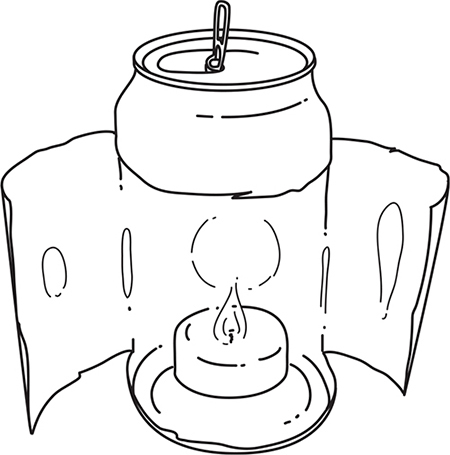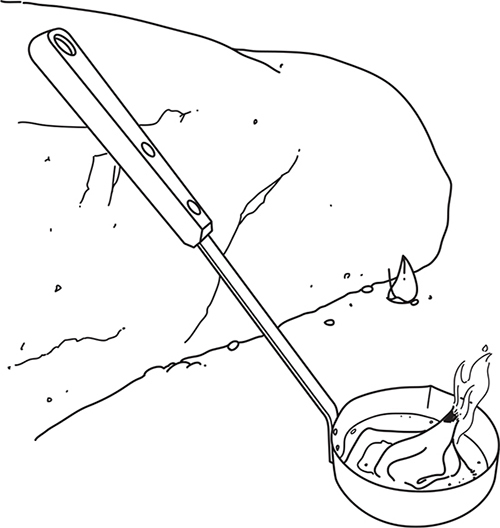Finger Clock
Air Goggles
Shadows Lead the Way
SIGNALING AND RESCUE HACKS
Bullet Casing Whistle
Busted Cell Phone to the Rescue
Glow Stick Buzz Saw
Rearview Rescue
Hansel and Gretel Survival
Staying put can be a good survival strategy in certain instances, such as when you’re lost. However, not having the option to move onward can be downright deadly. This chapter is filled with hacks that provide more options to keep moving forward. Sometimes in survival, movement is life.
Two elements that can stop a survivor dead in his or her tracks are lighting and navigation. In low-light, nighttime, or subterranean environments, the lack of a lighting tool means zero forward movement. Choosing to travel in darkness without a lighting tool can be dangerous and deadly. Without a tool to provide insight into direction, you can walk in circles or, worse yet, in the opposite direction of resources. In survival, every step forward should be with purpose.
The ultimate goal of every survival scenario is to make it out alive. For many, this involves being rescued. This chapter concludes with a small section dedicated to improvised rescue and signaling hacks. Whether during the day, at night, or along a trail, communicating to would-be rescue parties is a critical and valuable survival skill set.
LIGHTING HACKS
POP CAN LANTERN
The functionality of a modern lantern is very difficult to replicate using makeshift supplies. However, you’d be surprised at how much you can light up a small space with just a candle and a soda can (or any type of aluminum can for that matter). Carefully make 3 cuts in the can using your pocketknife as can be seen in the illustration. Then fold open the “wings” and place a candle inside. The shiny interior surface of the aluminum can reflects and projects the candlelight, creating a lantern effect in a dark room or cave. This can be used to not only navigate a dark building or trail but also to light up a food prep area. If you’re traveling, hold the lantern by the bottom where the metal does not get hot or suspend with a handle from the convenient pop tab bail.

HEADLAMP CAMP LANTERN
A headlamp can be quickly hacked into an outstanding camp lantern by placing it around a water-filled bottle using the head strap and with the light shining toward the center. The water diffuses and diverts the light, making a very comfortable camp lantern that can be much more pleasing to the eyes than blinding headlamps around the dinner table. It is also a slightly more discreet way of using a headlamp in the event that you are setting up a stealth camp or trying to remain undetected.
FLASHLIGHT DIFFUSER
Similar to the Headlamp Camp Lantern hack, an empty energy drink bottle with the shrink-wrapping removed can be fitted atop a bright flashlight to make a very functional little camp lantern. A flashlight is designed to project light in one direction in a focused beam. This isn’t always the best way to light a survival camp or shelter. Cut the top off of a mini energy drink bottle so that it fits snugly onto the face of a small flashlight. This solid, white plastic body acts like a lampshade to diffuse and spread the light in a much broader area.
LADLE SLUSH LAMP
The term “slush lamp” has dropped from most modern dictionaries—lost in history like so many other important survival skills. It is a crude lamp that typically burns on grease or animal fat. Eskimos used this style of lamp to burn seal blubber. However, the concept and principles can be applied to many different objects and fuels in a survival scenario. This hack uses the slush lamp model and 3 items found in almost any kitchen or grocery store—a ladle, some olive oil, and a strip of cotton fabric. Fill a ladle with olive oil and lay in the cotton strip (a cut piece of T-shirt works great) so that all but 1⁄2" is submerged in the oil. The lamp can be lit just like a candle once the 1⁄2" of protruding cotton “wick” absorbs the “fuel.” A slush lamp of this variety will burn very brightly and for a surprisingly long time.

T-SHIRT TORCH
When the sun goes down in the wilderness it’s game over without some kind of lighting tool. No flashlight means no work, no movement, and no progress—unless you know how to hack a good torch! It all starts with a fresh-cut green stick 1"–2" in diameter. It must be green because a dead one will catch on fire. Next tear a T-shirt (or any cotton fabric) into 1" strips and wrap those around the end of the stick like a giant Q-Tip. Soak the strips with a low-flashpoint cooking oil such as olive oil. Many cooking oils, including melted butter, margarine, or lard, will work for this. Bacon fat and pine sap are also suitable substitutions. Once the fabric torch head is soaked through, place it in the fire until it catches, and you’re good to go. A softball-sized wrap will burn for more than an hour.
CRAYNDLE
What do you get when you light the top of a crayon on fire? A crayndle, of course. Crayons are made up mainly of wax and burn very well. Leave the paper label on because it acts as the crayndle wick. An average crayndle will burn for 30 minutes. To keep them from falling over, melt the pointed writing tip into a small pool on a hard, fireproof surface and place the bottom of the crayon in the melted wax until it cools and hardens. This will prevent the crayndle from tipping or falling over. Need a bigger flame for more light or even cooking? Wrap several crayons together using wire. This will not only produce more light, but it creates a larger flame, which can be used to heat a small space if other types of fuel are limited.
ORANGE YOU GONNA USE THAT PEEL?
I love oranges. Did you know dried orange peels make great fire starters? However, this hack goes beyond using just the peel. An orange peel can actually be used to make a very impressive survival lamp. Peel the orange so that half the peel is intact and that the pithy central column is still attached. At this point the orange should look like a half-hollowed-out orange peel with the pithy core sticking up out of the center. Place the orange on a sturdy, hard, fireproof surface and fill with almost any kind of cooking oil such as olive oil or vegetable oil. The oil will slowly absorb into the pithy center column. After a few minutes, this pithy core can be lit just like a lamp wick and will continue to burn for several hours. Bonus hack: One of my favorite camp breakfasts is to bake instant rolls inside half rounds of hollowed orange peels right in the coals of a fire.
CRISCO CANDLE
If your childhood was anything like mine, then you grew up with a big can of Crisco in the pantry. My mom used Crisco for frying and homemade biscuits, but it wasn’t until recently that she learned a new use for Crisco: a 30-day candle. Crisco is a solid-state vegetable oil that also happens to burn incredibly well. A Crisco candle is best made with the long strands of a cotton mop head. Cut 1 strand off and cram it down into the can of Crisco using a thin, forked stick. Cut the end that sticks out to about 1" above the top and slather it with a little Crisco before lighting. One can of Crisco can burn up to 30 days. You’ll have to replace the wick several times, but it works as an amazing emergency candle. Burn 3 wicks at once for more light and heat. Insert them several inches apart.